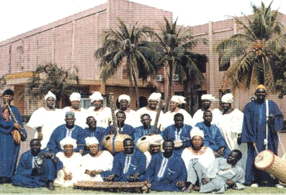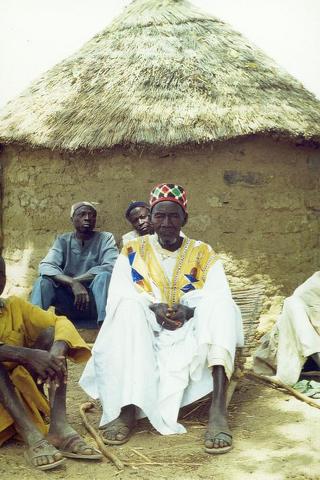
Burkina Faso's 22.1 million people belong to two major West African cultural groups: the Gur (Voltaic) and the Mandé. The Voltaic are far more numerous and include the Mossi, who make up about one-half of the population. The Mossi claim descent from warriors who migrated to present-day Burkina Faso and established an empire that lasted more than 800 years. Predominantly farmers, the Mossi are still bound by the traditions of the Mogho Naba, who hold court in Ouagadougou.

Dyula is a language of the Mande language family spoken mainly in Burkina Faso, Ivory Coast and Mali, and also in some other countries, including Ghana, Guinea and Guinea-Bissau. It is one of the Manding languages and is most closely related to Bambara, being mutually intelligible with Bambara as well as Malinke. It is a trade language in West Africa and is spoken by millions of people, either as a first or second language. Similar to the other Mande languages, it uses tones. It may be written in the Latin, Arabic or N'Ko scripts.

The balafon is a gourd-resonated xylophone, a type of struck idiophone. It is closely associated with the neighbouring Mandé, Bwaba Bobo, Senoufo and Gur peoples of West Africa, particularly the Guinean branch of the Mandinka ethnic group, but is now found across West Africa from Guinea, Burkina Faso, Mali. Its common name, balafon, is likely a European coinage combining its Mandinka name ߓߟߊ bala with the word ߝߐ߲ fôn 'to speak' or the Greek root phono.

The music of Mali is, like that of most West African nations, ethnically diverse, but one influence predominates: that of the ancient Mali Empire of the Mandinka. Mande people make up around 50% of Mali's population; other ethnic groups include the Fula (17%), Gur-speakers 12%, Songhai people (6%), Tuareg and Moors (10%).

Guinea is a West African nation, composed of several ethnic groups. Among its most widely known musicians is Mory Kanté - 10 Cola Nuts saw major mainstream success in both Guinea and Mali while "Yeke Yeke", a single from Mory Kanté à Paris, was a European success in 1988.

The Mossi are a Gur ethnic group native to modern Burkina Faso, primarily the Volta River basin. The Mossi are the largest ethnic group in Burkina Faso, constituting 52% of the population, or about 11.1 million people. The other 48% of Burkina Faso's population is composed of more than 60 ethnic groups, mainly the Gurunsi, Senufo, Lobi, Bobo, Bissa and Fulani. The Mossi speak the Mòoré language.
Bilgho Akaramata Kora, also known as Bil Aka Kora is a musician. He was one of the 17 children of Mahama and Teoura Bilgho. He is married to Astride, and is the father of Korane Prisca. Bil Aka Kora's sound draws upon traditional music from the language, instruments, rhythm and themes of the south of Burkina Faso.

The music of West Africa has a significant history, and its varied sounds reflect the wide range of influences from the area's regions and historical periods.
Articles related to Burkina Faso include:
Farafina is a music and dance group from Burkina Faso, established in 1978. The eight-member group is Burkina Faso's best known musical group, and one of Africa's most internationally prominent musical groups. The official website of the band announced that Farafina was working on a 2024 tour.

Ballaké Sissoko is a Malian player of the kora. He has worked with Toumani Diabaté and Taj Mahal, and is a member of the group 3MA with Driss El Maloumi and Rajery.
Mamadou Sidiki Diabaté is a prominent Mandé kora player and jeli from Bamako, Mali. He is the 71st generation of kora players in his family and a son to Sidiki Diabaté.
Victor Démé was a Burkinabé musician and singer-songwriter originating from a Mandinka family. His death was caused by a bout of malaria.
Amadou Traoré, better known as Amadou Balaké, was a popular singer from Burkina Faso. During his career, which lasted over 50 years, Balaké recorded and performed in different parts of West Africa as well as New York and Paris. In the early 21st century, he was a member of Senegalese salsa band Africando. His music combined different traditions from his home country, primarily Dioula (Mandé) and Mossi, as well as Afro-Cuban music.

Florent Belemgnegré, better known by his stage name Floby, is an Ivorian-Burkinabé singer and musician. He sings in the French and Mòoré languages. His music uses African sounds such as the kora and djembe but also rap and electric guitar.

Moulaye Dicko, better known by his stage name Dicko Fils, is a Burkinabé musician of Fulɓe origin. He sings and plays the kamale n'goni.
Firmin Boubié Bazié, better known by his stage name Agozo, is a Burkinabé singer.

Sofiane Balzak Kanazoé, also known by his stage name Sofiano, is a singer and composer from Burkina Faso. His music generally encompasses the afro-zouk and coupé-décalé genres. He has worked with the Burkinabé artists Floby, Dez Altino and Agozo and has performed in the Jardin de la Musique Remdoogo, a music and arts festival in the Burkinabé capital, Ouagadougou. Sofiano won two national Kundé awards, the Kundé of revelation and the Kundé of hope, in 2015.

Mamadou Diabaté is a Burkinabe musician mostly known for his balafon playing. He lives in Vienna, Austria and has toured internationally with his ensemble Mamadou Diabaté & Percussion Mania.

Tiga Wendwaoga Désiré Ouédraogo, better known by his stage name Dez Altino, is a Burkinabe singer and guitarist. He sings in the Mòoré and French languages, and most of his music falls under the coupé-décalé genre. He has collaborated on numerous occasions with other high-profile Burkinabé artists such as Floby and Agozo.
















